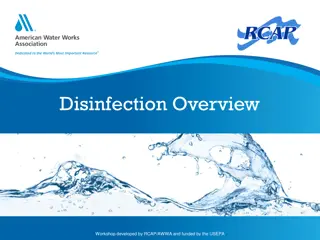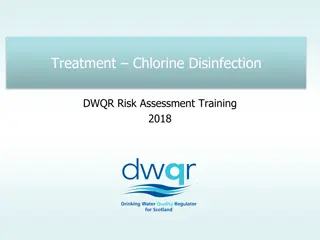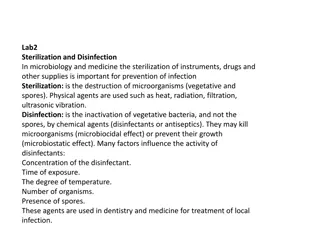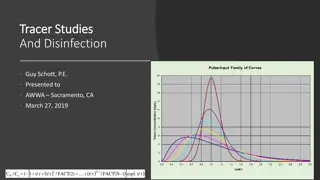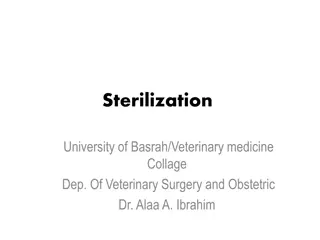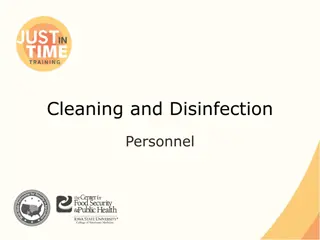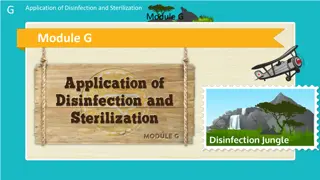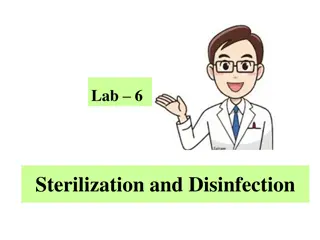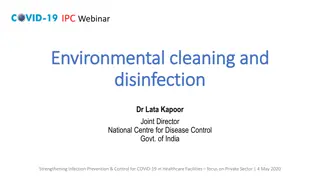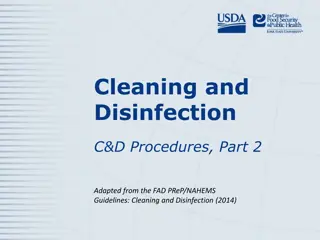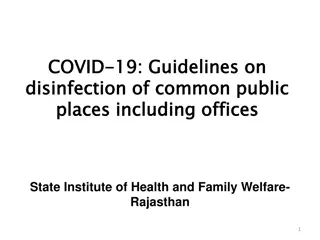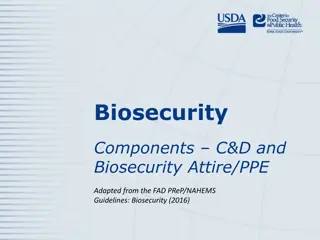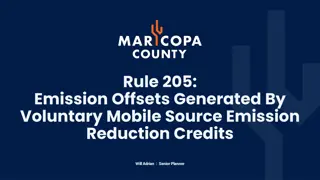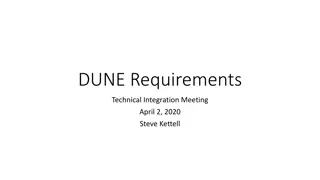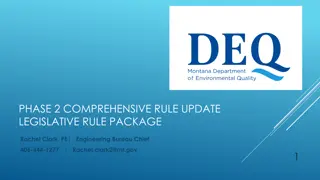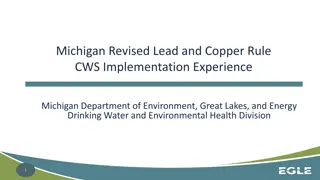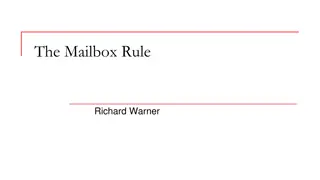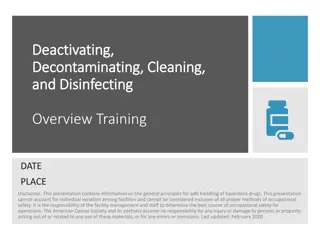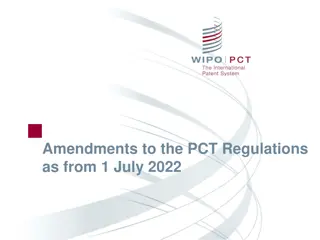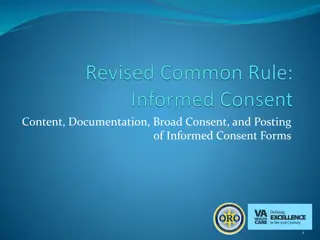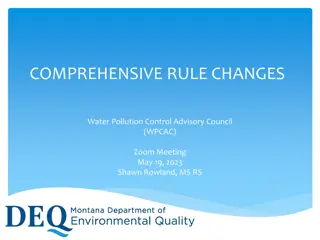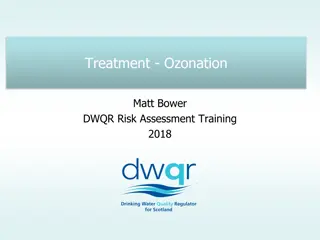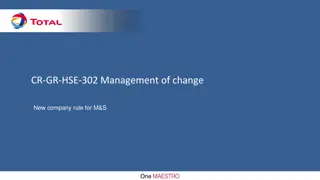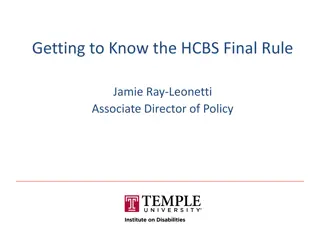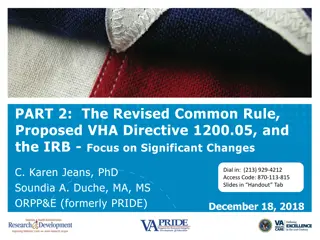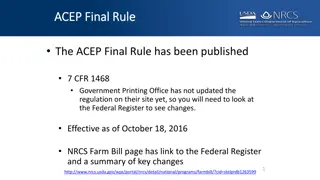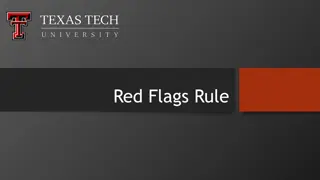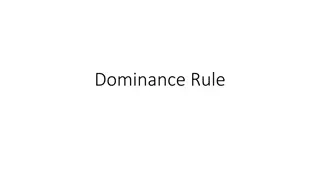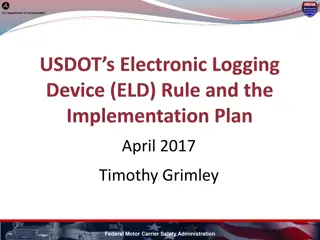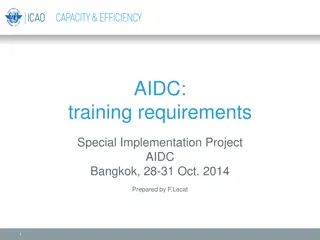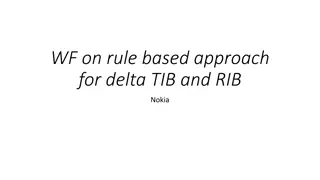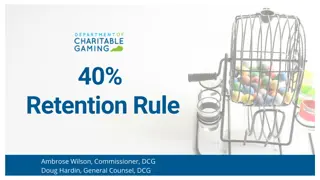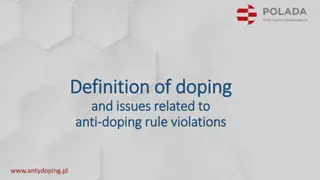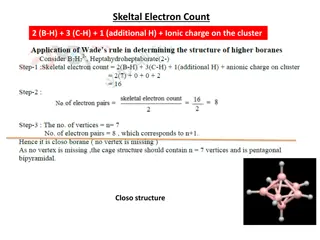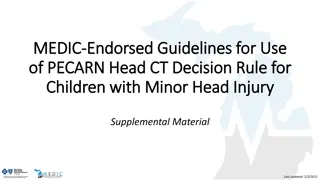Operator Training 2019: Disinfection Requirements Rule Overview
This training course provides a comprehensive overview of the Disinfection Requirements Rule for water system operators. Covering topics such as changes in disinfectant residual requirements, affected water systems, distribution system challenges, and more, operators will gain valuable insights and updates to ensure compliance and efficient operations. The course includes interactive activities to reinforce learning and comprehension.
Uploaded on Sep 13, 2024 | 0 Views
Download Presentation

Please find below an Image/Link to download the presentation.
The content on the website is provided AS IS for your information and personal use only. It may not be sold, licensed, or shared on other websites without obtaining consent from the author. Download presentation by click this link. If you encounter any issues during the download, it is possible that the publisher has removed the file from their server.
E N D
Presentation Transcript
Disinfection Requirements Rule Operator Training 2019 1
Introduction Workbook Not just a copy of slides More information/complete sentences for your reference later PowerPoint references workbook page number in lower left Activities throughout course: Apply what you learn Check for comprehension Credit for operators WB 1-1 2
Operator Training Agenda Lesson 1: Background Lesson 2: Monitoring and Reporting Lesson 3: Compliance Lesson 4: Distribution System Investigations Lesson 5: Overview of Best Management Practices Lesson 6: PN/CCR Lesson 7: Other Provisions 3
Disinfection Requirements Rule Lesson 1: Background Operator Training 2019 4
This lesson will cover Why the disinfectant residual requirements are changing The basis for the new requirements Rule basics 5 WB 1-1
Who is affected? DRR applies to: All Community Water Systems All Non-Transient Noncommunity Water Systems using chlorine disinfectant Transient Noncommunity Water Systems with: Filtration of a surface water source Filtration of a GUDI (Groundwater Under the Influence of Surface Water) source 4-Log disinfection of a groundwater source 6 WB 1-1
Background: Distribution Disinfectant Residual Beginning April 29, 2019: Minimum required distribution residual level will increase from 0.02 to 0.2 mg/L Free or total chlorine depending on the type of disinfectant Treatment Plant 7 WB 1-1
Background: Distribution System The distribution system presents many challenges: Finished water can undergo substantial changes due to physical, chemical, and biological reactions in the distribution system To make matters worse, as distribution systems age, deterioration can occur allowing contamination: Corrosion Erosion of pipe materials Eventual water main breaks Other areas of intrusion create pathways of contamination WB 1-1 8
Background: Distribution System Many different microbes can survive in the distribution system: Bacteria Viruses Protozoa Amoeba Cluster of E. Coli bacteria (magnified 10,000 x) A Legionella pneumophilia bacterium (green) caught by an amoeba (orange) Norwalk Virus WB 1-1 and 1-2 9
Distribution System: Biofilms Some microbes produce biofilms in the distribution system: Biofilms can trap other material, organisms and contaminants Under various circumstances, biofilms can release trapped contaminants (slow release mechanism) WB 1-2 10
Background: Distribution System Factors that influence pathogen survival and growth in the distribution system include: Water chemistry (temperature, pH, etc) Presence of nutrients System hydraulics Sediment accumulation Presence (or absence) of disinfectant residual WB 1-2 11
Background: Distribution System Maintenance of an adequate residual: 1. Prevents or limits regrowth of microorganisms in the distribution system 2. Inactivates microorganisms that may enter the system through: cross-connections main breaks zero or negative pressure situations Cl2 Cl2 WB 1-2 12
Still a Problem Despite advances in water treatment and management, waterborne disease outbreaks continue to occur in the United States. 2009-10 study: CDC determined that the large proportion (78%) of illnesses observed in outbreaks involved distribution system deficiencies. # O U T B R E A K S WB 1-3 13
Still a Problem Pennsylvania: Nearly all outbreaks since 2010 have been associated with distribution system deficiencies and Legionella In 2017, there were 90 E. Coli MCL violations at 79 different public water systems The distribution system is the remaining component yet to be adequately addressed in efforts eliminate waterborne disease outbreaks. WB 1-3 14
Establishing a New Residual Requirement PA sought to establish a distribution residual requirement that is both truly detectable and controls microbial growth First: What is a true detectable residual? It was determined that the previous 0.02 mg/L was not truly detectable Analyzers cannot accurately read that low WB 1-4 15
True Detectable Residual DEP reviewed several studies to determine the true lower detection limit Example: Colorado Dept of Health and Env: Analyzed data from 450 samples Detection limit determined to be 0.09 mg/L WB 1-4 16
True Detectable Residual What is a true detectable residual? EPA established a practical quantitation limit of 0.1 mg/L for the approval of free chlorine residual methods (lowest quantifiable limit) Also, all chlorine residual test methods are subject to interference from iron, manganese, and DBPs Based on all this information, a true detectable residual is likely somewhere between 0.1 and 0.2 mg/L WB 1-4 17
Establishing 0.2 mg/L Level DEP s next step: Established a residual that is not only detectable, but also controls microbial growth DEP reviewed and considered: Numerous studies Other states disinfection residual requirements Industry standards WB 1-4 18
Establishing 0.2 mg/L Three studies highlighted in your workbook Studies found substantially more coliform and E. coli positives when residuals were <0.2 mg/L Review of other states residual requirements: 19 states have requirements that are >0.2 mg/L WB 1-5 19
Establishing 0.2 mg/L Industry Standards: Ten State Standards specifies a minimum free chlorine distribution residual of 0.2 mg/L Widely accepted standards created by the Greater Lakes-Upper Mississippi River Board of State and Provincial Public Health and Environmental Managers WB 1-6 20
Establishing 0.2 mg/L Industry Standards: Water Research Foundation (WRF) recommends a free chlorine distribution residual of 0.20 mg/L for optimized distribution EPA s Area Wide Optimization Program for Distribution Systems recommends maintenance of >0.20 mg/L free chlorine at all times in the distribution WB 1-6 21
Establishing 0.2 mg/L Based on all this information and industry input, PA established a minimum distribution residual requirement of 0.2 mg/L Treatment Plant WB 1-6
Overview The DRR establishes: Sample siting plan requirement Minimum distribution disinfection residual level of 0.2 mg/L beginning 4/29/19 Weekly monitoring Revised reporting requirements Distribution system investigation Note: For groundwater systems, the 4-log Entry Point requirement of >0.40 mg/L (or permitted level) DID NOT CHANGE. WB 1-7 23
Overview The DRR also revises some requirements for surface systems: Requires filter plants to maintain > 0.20 mg/L residual at the entry point. Requires filter plants to calculate Giardia log inactivation at least once/day and report this value to DEP WB 1-7 24
Overview Other provisions: DRR requires systems that provide chloraminated water to develop and implement a nitrification control plan. Covered in last lesson in course WB 1-7 25
Key Points The minimum required distribution disinfection level is changing from 0.02 mg/L to 0.2 mg/L to be: A truly detectable level A residual that controls microbial growth Complying with the new rule will be covered in this course WB 1-7 26


